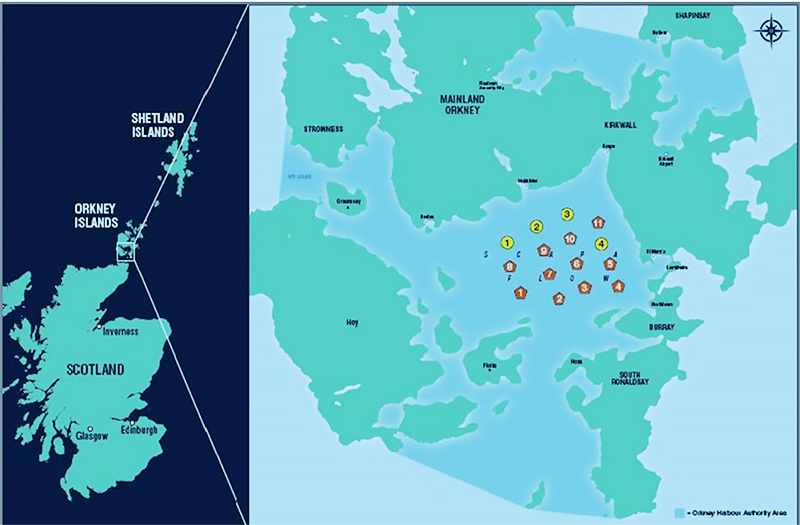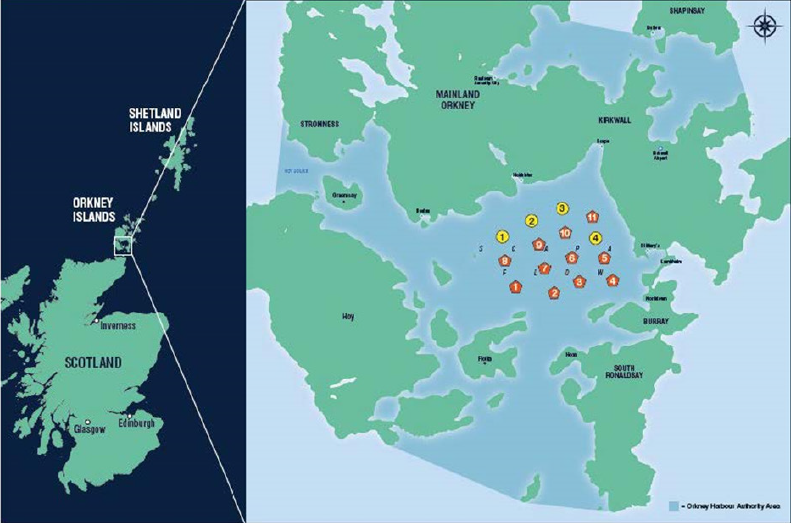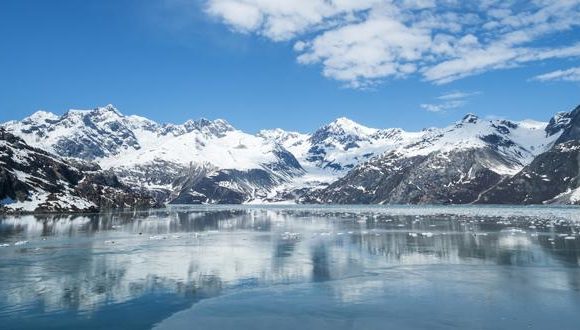Orkney Harbour – BQUA Plus test kit evaluation for a local port authority ballast water policy

Case Study | Ballast water sample analysis: Comparing ATP to preserved sample analysis | July 2022
Overview
Orkney Islands Council (OIC) approved and implemented a Ballast Water Management Policy in 2013 for Scapa Flow (Figure 1) following the International Maritime Organization Ballast Water Management Convention (IMO BWMC) D2 Standard. The OIC ballast water management policy is a local harbour authority policy and is not part of compliance monitoring by port state control. The UK has yet to implement the IMO BWMC, accession and implementation were scheduled for 2020 but was delayed due to the COVID-19 pandemic. The OIC ballast water management policy states that all vessels wishing to discharge ballast water (BW) must exchange and treat ballast water using a ballast water treatment system (BWTS) before entering Scapa Flow. Ballast water management policies, like the Orkney Island Council’s BW Management Policy (the Policy from hereon), are implemented to prevent the release of invasive and non-native species or pathogens to marine ecosystems from the discharge of untreated ballast water from ships. The release of these non-indigenous organisms can disrupt marine ecology and could potentially cause substantial environmental and economic impacts. The Policy specifies approved BW exchange areas and includes BW monitoring as a way of ensuring compliance with the Policy. The BW monitoring program is carried out by the Orkney Harbour Authority – this being part of Orkney Islands Council.

Figure 1: Orkney Harbour Authority Area, Scapa Flow, Scotland, UK. Yellow circles: Shipto-Ship Transfer Locations, Orange pentagons: Anchorage Locations.
Adenosine triphosphate (ATP) is present in all living cells acting as an energy transporter in metabolic processes. Since it is found in all living cells, it can be used as a true indicator of living organisms in a sample. The LuminUltra BQUA Plus Ballast Water Monitoring Kit is specialized for measurement of ATP in ballast water to provide clear indications of discharge compliance in the three organism size fractions in the D-2 Standard set by the IMO BW Management Convention. The BQUA Plus kit is accurate, rapid, and portable, allowing it to be used on board vessels or in a laboratory.
In this study, the BQUA Plus test kit was assessed over the course of seven months by the Orkney Harbour Authority to determine the ease of use of the equipment and to compare results with their current plankton analysis method involving preservation and taxonomic analysis. The Orkney Harbour Authority has been collecting and testing ballast water since 2015. The interest in an alternative method was driven by the increased number of vessels visiting Scapa Flow with operational BW treatment systems on-board. The Orkney Harbour Authority required a quick, on-the-day indicative analysis to test treated ballast water which would provide results within hours and therefore the decision was made to trial the BQUA Plus test kit.
Methodology
The BQUA Plus test kit was used over the course of seven months with 10 sampling events. Two sets of samples were collected at the same time, one to be preserved for detailed sample analysis, and another for ATP analysis. All sample analysis was conducted in laboratory.
Sample collection (Orcades Marine Management Consultants Ltd) was carried out on deck, water was pumped from the middle of the water depth within the ballast water tank using a hand operated pump. The water was filtered and concentrated using nets to obtain the small fraction (≥10µm) and large fraction (≥50µm) samples. For both the preserved and ATP analysis three replicate samples were collected for each sample type (Table 1).
For small fraction plankton analysis each replicate sample was obtained by filtering 10 L of ballast water using a net with 10µm mesh and concentrating it to 0.5 L, for ATP analysis samples were concentrated to 1L. For large fraction plankton analysis each replicate sample was obtained by filtering 100 L of ballast water using a net with 50µm mesh and concentrating it to 1 L. For preserved phytoplankton, only small fraction samples were collected as the two fractions were separated from the sample during laboratory analysis.
Table 1: Number of samples collected per sampling event.
|
|
Small fraction ≥10µm ≤50µm |
Large fraction ≥50µm |
|
Preserved, detailed analysis |
||
|
Phytoplankton |
3 |
Large fraction separated from small fraction samples at laboratory |
|
Zooplankton |
3 |
3 |
|
ATP Analysis |
||
|
Plankton |
3 |
3 |
Phytoplankton samples were preserved in Lugol’s solution and the zooplankton (small and large fraction) were stained with neutral red and preserved in 4% formalin for later detailed analysis. The preserved samples were sent to a taxonomic laboratory (APEM Ltd) for analysis of number of viable and non-viable organisms, and identification of all plankton to species level. Separate samples were used for ATP testing within 6 hours of sample collection.
Results and Discussion
The compliance results from 10 sampling events analyzed in triplicate using the BQUA Plus test kit for ATP measurement and a detailed analysis method are shown in Table 2. The green cells indicate compliance with the D2 standard, yellow indicates the sample is close to limit, and red indicates likely not compliant. For the ≥ 10 µm ≤ 50 µm size fraction, the ATP analysis using the BQUA Plus test kit had 100% agreement with the detailed analysis. For the ≥ 50 µm size fraction the ATP analysis agreed with both the phytoplankton and zooplankton results in 73% of samples and agreed with both or at least one of the phytoplankton and zooplankton results in 93% of samples.
Table 2: ATP measurements of two size fractions of ballast water (≥50 µm and ≥10 < 50 µm) samples compared to detailed analysis results. Green cells indicate compliance with the D-2 standard, yellow indicates the sample is close to the compliance limit, and red indicates not compliant.
|
|
Management Approach |
Replicate |
≥ 50 µm |
≥ 10 µm ≤ 50 µm |
||
|
ATP |
Preserved, detailed analysis |
ATP |
Preserved, detailed analysis |
|||
|
1 |
Filtration and electrolysis |
1 |
147,521 0 13 0.045 |
|||
|
2 |
41,255 |
840 |
9 0.019 |
|||
|
3 |
61,570 |
1,673 1,861 |
3 0.039 50 0.002 |
|||
|
2 |
Filtration and electrolysis |
1 |
4,942,425 |
|||
|
2 |
2,463,796 |
1,764 |
51 0.003 |
|||
|
3 |
310,334 |
140 253,303 |
49 0.001 – 0.191 |
|||
|
3 |
Electrolysis |
1 |
6,021,010 |
|||
|
2 |
8,744,555 |
194,951 |
277 0.253 |
|||
|
3 |
3,341,984 |
278,364 |
215 0.183 |
|||
|
4 |
Electrolysis |
1 |
13,272 0 2 0.001 18,307 0 2 0 |
|||
|
2 |
||||||
|
3 |
4,577 0 2 0 |
|||||
|
5 |
Filtration and electrochlorination |
1 |
18,844 0 1 0 |
|||
|
2 |
82,779 0 1 0.001 12,451 0 1 0 |
|||||
|
3 |
||||||
|
6 |
Filtration and electrochlorination |
1 |
24,826,986 |
23,660 |
29 0.04 |
|
|
2 |
30,820,539 |
27,429 |
40 0.04 |
|||
|
3 |
345 |
23,518 |
97 0.04 |
|||
|
7 |
Filtration and electrochlorination |
1 |
13,856 7,496 |
0 933 0 |
1 0 1 0.005 |
|
|
2 |
||||||
|
3 |
2,044 |
1 n/a 2 |
0.004 |
|||
|
8 |
Filtration and electrolysis |
1 |
44,215 0 |
0 |
||
|
2 |
14,274 933 |
0 |
||||
|
3 |
17,198 0 2 0 |
|||||
|
9 |
Filtration and lectrolysis |
1 |
2,427,640 |
16,791 |
17 0.01 |
|
|
2 |
2,404,423 |
2,799 |
19 0.004 |
|||
|
3 |
n/a |
21,375 |
20 0.005 |
|||
|
10 |
Filtration and electrodialysis |
1 |
n/a 31,908 |
40 – 0.001 |
||
|
2 |
30 – 0 |
|||||
|
3 |
5,164 |
948 |
1 0 |
|||

Due to a high level of agreement between the ATP analysis using the BQUA Plus test kit and the detailed analysis, the Orkney Harbour Authority decided to update their BW monitoring program. From January 2022 onwards the BQUA Plus test kit has been in use by the Orkney Harbour Authority to test ballast water from vessels with operational ballast water treatment systems. This change has required the updating of
the vessel pre-arrival forms which now include OIC Harbour Authority specific Ballast Water Treatment System notification form. On the completion of BW sample collection and on-the-day ATP analysis, the BW result documents are sent to the Orkney Harbour Authority management team and to the vessel on the day of the sampling and testing.
Conclusion
LuminUltra’s BQUA Plus Ballast Water test kit is now used by Orkney Harbour Authority to test BW from vessels wishing to discharge treated ballast water into Scapa Flow. This rapid and accurate method of compliance testing prevents the need for costly detailed analysis, allowing efficient management of ballast water in the Scapa Flow.
Business Development Manager
Marine Services
Harbour Authority Building
Scapa, Orkney
KW15 1SD
Tel: 01856 873636 Ext 3610
Mob: 07595 091 393
E-mail paul.olvhoj@orkney.gov.uk















